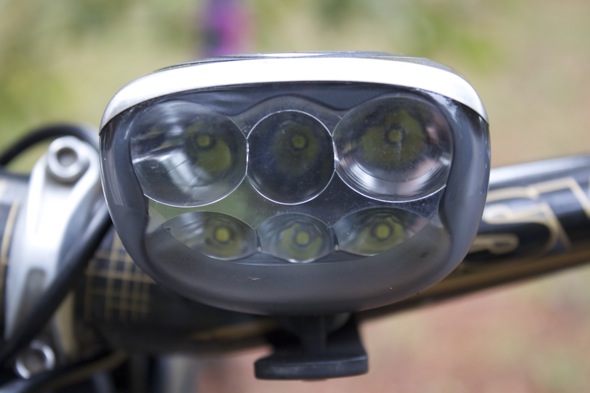I probably mountain bike at night more than most folks – usually once a week year ’round, including the summer. One thing I’ve found is that nothing takes the fun out of a night ride more than having a bad light. A proper mountain bike light should be durable and reliable while offering proper illumination on the trail, allowing you to ride the same way you ride during the day. The Light & Motion Seca 800 does all of the above better than any light I’ve owned.
So let’s start with the stats. On paper the Seca 800 features 6 LEDs pumping out 800 lumens for 2 hours and the whole package (battery and head unit) weighs in at 341 grams. In the real world the numbers turn out even better – I got at least 2:15 run-time on high at 328 grams. There are settings for low, medium, high, and flash mode; charging time is about 2.5 hours. Viewed from the side the Seca 800 looks like a bank of stadium lights torching the singletrack.
On the trail the first thing mountain bikers will notice about any lamp is the beam pattern and projection. Light & Motion likes to point out that lumen count is just one factor in determining a light’s effectiveness; the pattern the light forms is almost equally as important. And this is where the difference between the Seca 800 and a single bulb and reflector unit is readily apparent. The Seca 800 beam is hotspot-free and works equally well mounted on the bars or the helmet.
That last bit is a big deal (to me anyway). A bright single bulb light works OK as a helmet lamp because you can turn your head to point the light where it’s needed at any given time. But oftentimes that means making unnatural movements or worse, taking your eyes off the line in front of you when you can least afford to do so. Mounting the Seca 800 on the bars also places the weight of the light and battery on your bike rather than on your helmet or in your jersey pocket.
Even mounted on the bars and without a supplementary helmet lamp, the Seca 800 does a great job illuminating short drops and low hanging tree branches, better than any other light system I’ve used. On the trails I typically ride I’ve found I can get away with keeping the light set on low or medium for most of the ride, though I suppose if I was a faster rider I’d need to ramp up to high more often.
 The included bar / helmet mount clamping system is really simple and effective – just pull the rubber strap tight and hook it over the plastic pin. Once the strap is in place it doesn’t move; in fact it’s so stubborn that whenever I need to angle the light up or down slightly I have the release the strap – it’s that tight.
The included bar / helmet mount clamping system is really simple and effective – just pull the rubber strap tight and hook it over the plastic pin. Once the strap is in place it doesn’t move; in fact it’s so stubborn that whenever I need to angle the light up or down slightly I have the release the strap – it’s that tight.
Light & Motion uses robust cable connectors that create serious suction to keep everything connected during the ride. There’s nothing worse than having a cable snagged and suddenly being left in the dark. In more than 2 months of riding with the Seca 800 I haven’t had a cable jiggle loose or get disconnected.
The Seca 800 features an intelligent power management system that warns you when you’re running low on battery power. In my tests, after about 2 hours, 15 minutes on high the lamp dimmed a little. According to the manual, the green LED on the power button should start blinking at this point but mine never did (this isn’t really helpful anyway if the light is on your helmet). After the initial dimming I got more than an hour and fifteen minutes (!) of additional run-time on high, though at a slightly lower light output level. With just a few minutes of run-time remaining, the Seca dropped the light output again and flashed the main lamps. At this point the green LED on the power button should also flash rapidly. With such a conservative warning system, I never worried about being caught out in the dark by surprise.
High, medium, and low settings simulated using Adobe Lightroom software. Can’t see much difference? You get the same effect on the trail at night – switching from high to medium doesn’t change the beam pattern, just the intensity (and even that’s subtle as you toggle from high to medium to low).
I love the sleek headlamp design and even the battery is well thought out with a groove on one of its three sides to fit snugly against a frame tube or stem. The power button could use a little work in my opinion – it’s hard to find, especially with a gloved hand and it’s also hard to tell when you’ve pressed it since the button “click” isn’t very positive. A rubberized button might be just the trick here so the texture stands out from the smooth metal and plastic surface on top of the lamp.
If you’re looking to extend your mountain bike season with a new light this fall, don’t let lumen counts and battery life numbers blind you to what’s really important: performance on the trail. The Light & Motion Seca 800 ($499 MSRP, $129 for an extra battery) is easily the best light system I’ve owned and offers reliable, effective illumination in a variety of terrain. Don’t get caught out in the dark this fall!
















11 Comments
Oct 12, 2011
Oct 12, 2011
There is a way to put the light into "race mode" which just gives you two light settings to toggle between (hi and lo). Still, you gotta push the button and there's no fine tuning for say medium speed.
Oct 13, 2011
@Trek7k; Any idea how it compares with a Lights & Motion HID, I have one, and it gives a great spot beam and so so wide beam. Looking for something to fill in the closer stuff.
Oct 13, 2011
Oct 12, 2011
Oct 13, 2011
In terms of the beam pattern, L&M is constantly tweaking the reflectors so I'm guessing there is a big difference, especially if your HID is a few years old. The Seca 800 has a bank of 3 large LEDs on top and 3 smaller LEDs below. The lower bank has a frosted plastic cover which helps diffuse the light, sorta like fog lights on a car.
Oct 12, 2011
Oct 13, 2011
Oct 12, 2011
@fat_billy, yeah, the woods do tend to stare back at you a little. And depending on time of year and where you are, the intense lights really attract those giant hornets, so it gives incentive to keep moving!
Oct 12, 2011
Oct 13, 2011